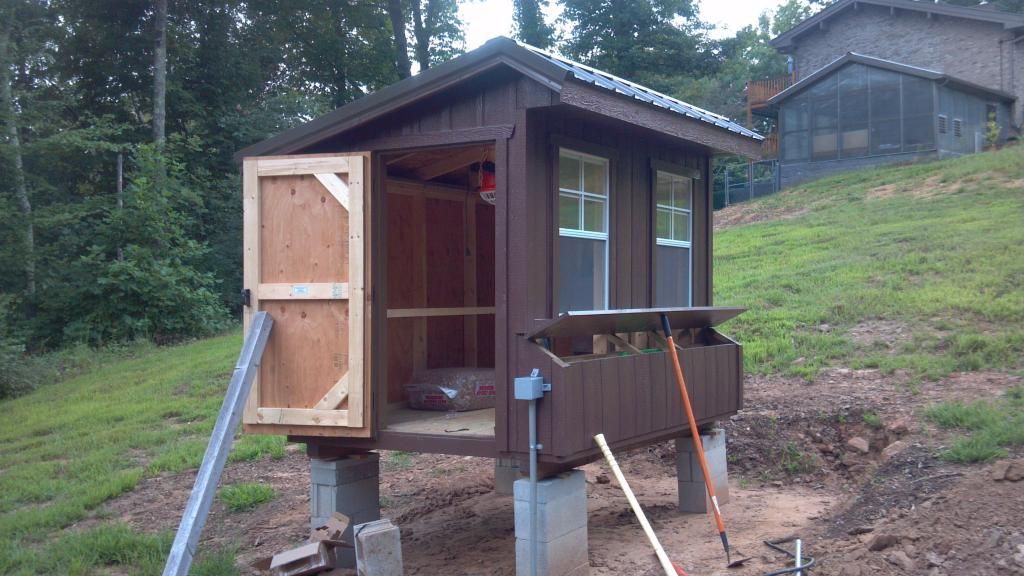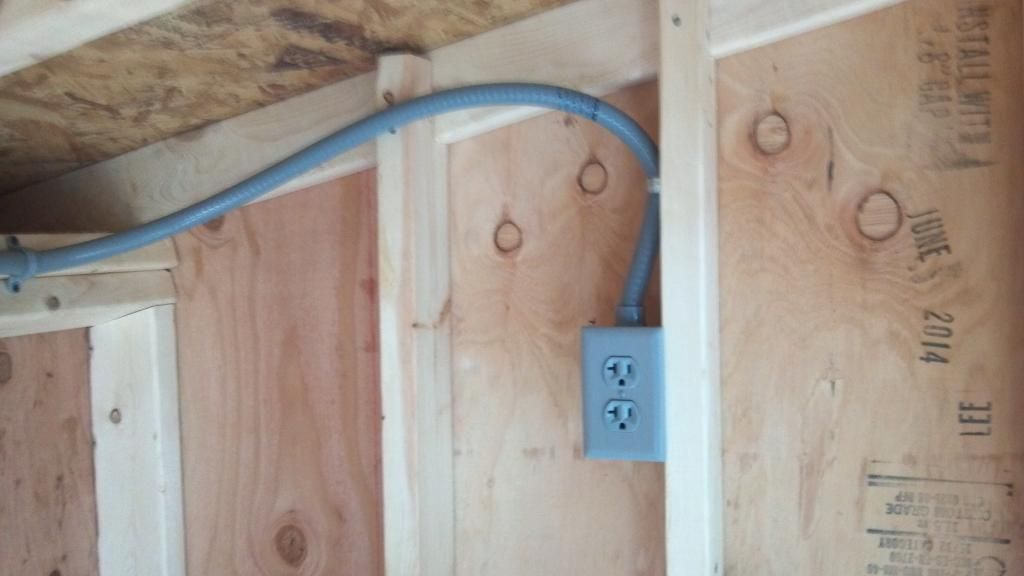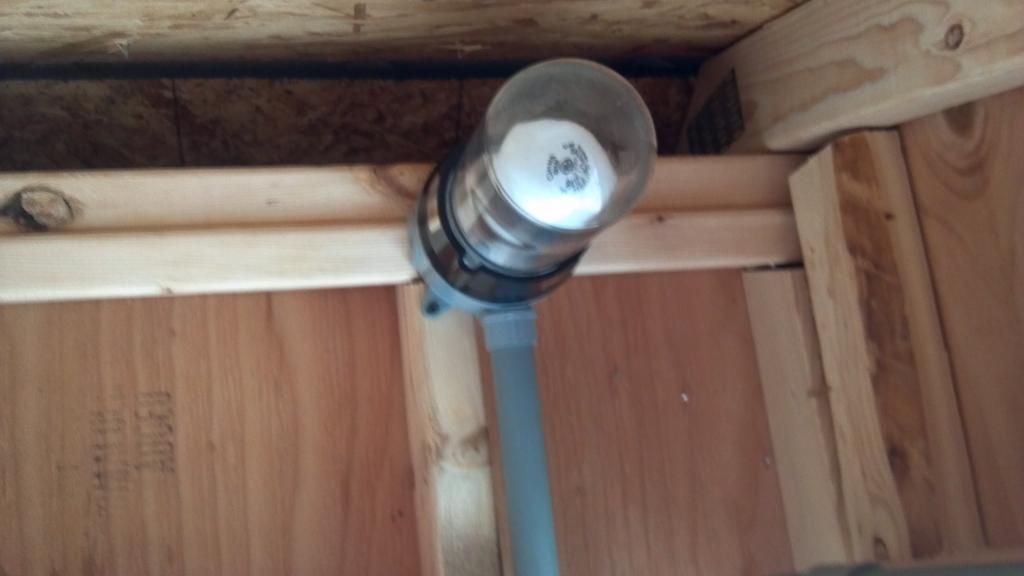You are using an out of date browser. It may not display this or other websites correctly.
You should upgrade or use an alternative browser.
You should upgrade or use an alternative browser.
Wiring method for chicken coop
- Thread starter T74
- Start date
- Status
- Not open for further replies.
david
Senior Member
- Location
- Pennsylvania
yes 547.1 (A) and (B)
petersonra
Senior Member
- Location
- Northern illinois
- Occupation
- Semi-retired engineer
I'm wiring a chicken coop for a homeowner. its about 4'x8', pretty much just a shed.
Walls will be finished so the wiring will be concealed. Do I still need to follow 547.5 for wiring methods?
What kind of chicken coop has FINISHED walls?
I would look closely at 547.1 and see if there is even a remote chance that this chicken coop is covered.
How does one determine "other cables or raceways suitable for the location"?...wiring will be concealed. Do I still need to follow 547.5 for wiring methods?
How does one determine "other cables or raceways suitable for the location"?
I was just wondering that too...
PVC?
PVC is specifically mentioned as rigid nonmetallic.I was just wondering that too...
PVC?
petersonra
Senior Member
- Location
- Northern illinois
- Occupation
- Semi-retired engineer
I don't think it matters since it would not appear to be covered by article 547. This is more akin to a dog house than an ag building.
K8MHZ
Senior Member
- Occupation
- Electrician
Do they make insulated chicken wire?

K8MHZ
Senior Member
- Occupation
- Electrician
I don't think it matters since it would not appear to be covered by article 547. This is more akin to a dog house than an ag building.
547.1 (B) Such buildings include areas where the following exist: (1) Poultry and animal excrement may cause corrosive vapors.
Sounds like a chicken coop to me.
Certainly does.547.1 (B) Such buildings include areas where the following exist: (1) Poultry and animal excrement may cause corrosive vapors.
Sounds like a chicken coop to me.
(A) Excessive Dust and Dust with Water. Agricultural
buildings where excessive dust and dust with water may
accumulate, including all areas of poultry, livestock, and
fish confinement systems, where litter dust or feed dust,
including mineral feed particles, may accumulate.
kwired
Electron manager
- Location
- NE Nebraska
- Occupation
- EC
What kind of chicken coop has FINISHED walls?
I would look closely at 547.1 and see if there is even a remote chance that this chicken coop is covered.
Define Finished.
In poultry and other livestock buildings there may not be drywall and paint, but there may still be a covering on the wall to protect any wall contents which may only be thermal insulation, but could be wiring, plumbing etc as well from the occupants of the building or even to help facilitate sanitation of the building.
547.1 A and B both mention poultry, so this is likely a 547 application from early on in determination.
Main points of emphasis on this one are to pay attention to wet or corrosive environment and to determine if an equipotential plane is required.
My suggestion on such a building is to place service/supply equipment and other components that don't need to be inside on exterior to help with corrosion issues.
The size of this shed suggests to me it is not a high production unit and is even kind of small for even personal production purposes but is rather a hobby or pet thing, but that doesn't change the fact that animal excrement will cause corrosive environment on some level and that it likely will be washed at times. But a building that size likely doesn't have complex environmental air, feed, water or waste management equipment and that alone greatly reduces the possible need for an equipotential plane.
I think the equipotential plane is more important or even critical for 4 legged critters with longer "wheel bases" but 547 does not really discriminate this and the rule applies to all livestock.
Compared to the 1000 foot long poultry buildings that I have worked on before it is quite simple and likely only has a lighting outlet or two and some receptacles for heat lamps and that may be about it. Maybe a heated water supply to prevent it from freezing.
Last edited:
petersonra
Senior Member
- Location
- Northern illinois
- Occupation
- Semi-retired engineer
have you ever seen a hobby type chicken coop like this? the half dozen chickens that are typically found in them do not create enough excrement for the excrement to create corrosive conditions.
I don't know what electricity would be needed in such a structure anyway. Most of the ones I have seen like this are on skids so they can be moved around. The coop only needs electricity typically for lighting and heat, and sometimes for heat to keep the chicken watering system from freezing up. You could probably run emt on the outside of the structure rather than trying to put it in the walls.
I don't know what electricity would be needed in such a structure anyway. Most of the ones I have seen like this are on skids so they can be moved around. The coop only needs electricity typically for lighting and heat, and sometimes for heat to keep the chicken watering system from freezing up. You could probably run emt on the outside of the structure rather than trying to put it in the walls.
- Location
- Bremerton, Washington
- Occupation
- Master Electrician
If you are in Washington that size building would be exempt from the NEC.
kwired
Electron manager
- Location
- NE Nebraska
- Occupation
- EC
But a temporary service on an even smaller post probably is not:huh:If you are in Washington that size building would be exempt from the NEC.
Guess maybe people need to put those temps on small chicken coops if they don't want to have them inspected
- Occupation
- Licensed Electrician
This is a back yard chicken coop for Pete's sake. Some UF wire, some conduit for protection from physical damage, maybe go full on pipe and thhn, add some GFCI protection.........good to go, right? That's way I see it.
I'd just use UF/NMC. OP said concealed in walls. Conduit where wiring is external to walls. IMO, GFCI is not required for inside-only accessible receptacles.This is a back yard chicken coop for Pete's sake. Some UF wire, some conduit for protection from physical damage, maybe go full on pipe and thhn, add some GFCI protection.........good to go, right? That's way I see it.
kwired
Electron manager
- Location
- NE Nebraska
- Occupation
- EC
GFCI requirements depend on if conditions of 547.5(G) exist. All of them except for "outdoors" are still a possibility inside this building.I'd just use UF/NMC. OP said concealed in walls. Conduit where wiring is external to walls. IMO, GFCI is not required for inside-only accessible receptacles.
shortcircuit2
Senior Member
- Location
- South of Bawstin
NMC is not available anymore. UF is basically the replacement cable for NMC for some time now I believe.
I would just use UF wire for the little coup. Upgrade to PVC where exposed to damage.
Could use PVC coated MC in some 547 building locations. This could be an example of "other wiring method".
Here is some here...http://www.southwire.com/products/ArmorliteTypeMCPVCJacketed.htm
I would just use UF wire for the little coup. Upgrade to PVC where exposed to damage.
Could use PVC coated MC in some 547 building locations. This could be an example of "other wiring method".
Here is some here...http://www.southwire.com/products/ArmorliteTypeMCPVCJacketed.htm
- Location
- Tennessee NEC:2017
- Occupation
- Semi-Retired Electrician
Agree. My statement was based on the mental picture I have of the OP scenario. Specifics which exclude the other possibilities were not stated.GFCI requirements depend on if conditions of 547.5(G) exist. All of them except for "outdoors" are still a possibility inside this building.
- Status
- Not open for further replies.





